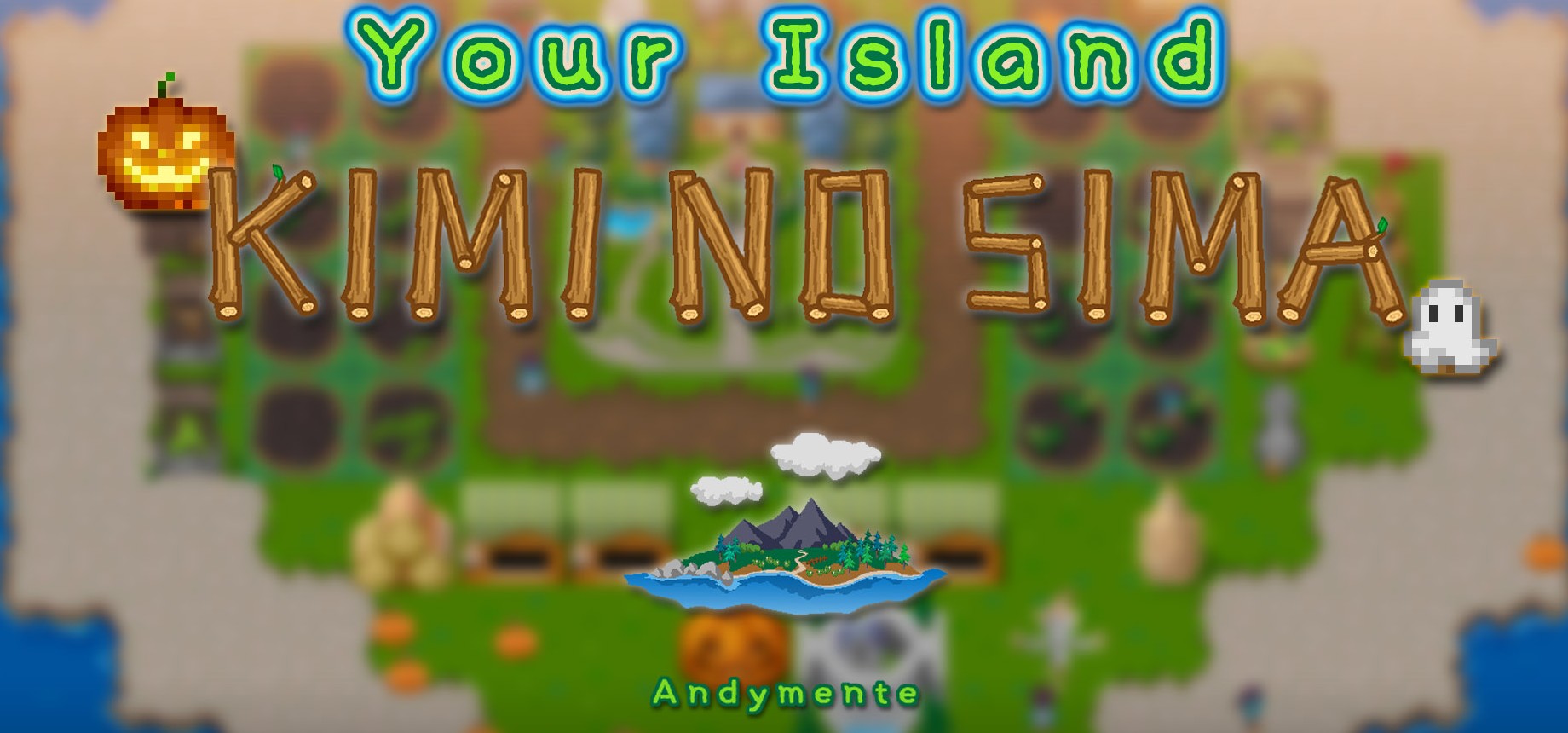So indie it hurts, this game has a few good ideas buried under the worst possible interface.
Type: Single-player
Genre: Simulation, Strategy,
City-Builder
Developer: Andymente
Publisher: Andymente
Release date: 16 Oct, 2019


Intro
I’m very heavily of two minds about this game.
On the one hand, it’s clearly a labor of love by a single developer trying his very best to make his own dream game. He’s so eager, he posts daily updates on what he’s doing and responds to basically everything on the forum, and that’s just adorable.
On the other hand, this isn’t just a terrible interface, the fact that some fixes to the interface are buried behind massive “Ark” costs shows he’s actually making the game frustratingly opaque on purpose, and he should be slapped and told how games are supposed to be fun for the player as well as the developer.
(Also, just in case anyone is curious, the game’s developer is Japanese, it’s originally called “きみの島”/”Kimi no Shima”, and directly translates into “Your Island”, so don’t worry what the weird part after “Your Island” in the title means.)
Your soul has just fallen on this island.
Before starting the game, you need to allow an island to be procedurally generated. Things don’t get off to a great start when the confirm button is a windows popup box that isn’t even translated. There’s… a lot of rough edges with this localization job. For that matter, there’s a lot of rough edges with everything about the interface. The game apparently doesn’t work with the Steam interface at all, presumably because the developer doesn’t know how, so all my screenshots had to come from hitting the ‘Print Screen’ button. There are no options to rebind any of the keys, and while most of the key bindings are fairly standard, you have to either hit the ‘+’ and ‘-‘ buttons on the side of the screen or hit Page Up or Page Down to zoom in because there is no support for scroll wheels. That said, the developer seems fairly responsive, so maybe these are all temporary issues that might get resolved after being told about them… But I’m already a paragraph in on the interface alone, and haven’t even started talking about the game, itself yet….

There are options for island size and difficulty, which makes you start out with more or less islanders and buildings already constructed, but also affects rates of random bad things like disease and fire. Beyond that, your island also has a “special product”, which is one crop that grows well (I’m not sure if this just makes that one type of farm unlock early, or if it changes requirements so it can be grown more easily), as well as an “animal friendly”, which is the same idea, but for livestock. Beyond that, your island is shaped like a rectangle, but has a randomized east-west river and a north-south river. Before confirming the island you will take, you can view it in highly zoomed-out form, and reroll your island and its specialties as much as you like to get whatever you’re looking for. After hitting “OK”, you’re dropped down to your mindless minions, and told how your soul just fell on this island in a pop-up box. Get used to pop-up boxes, they happen for a lot of “firsts” and “tenths” of various things.
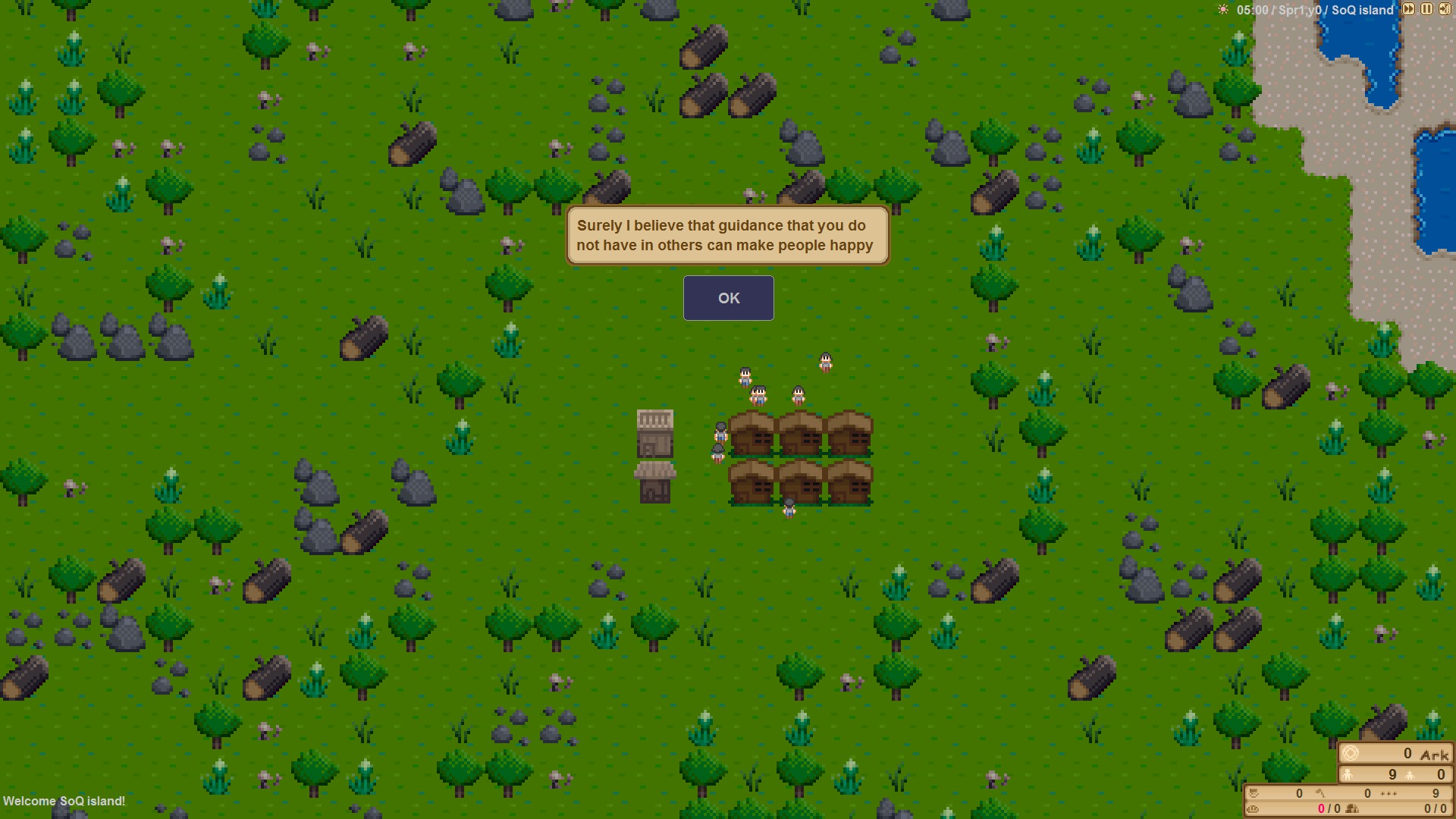
All Your Base
I cannot go much further in this review without talking about the massive, massive problems with the Engrish in this game. This is a indie Japanese game, so I was fully expecting some grammar errors, but the sheer degree of Engrish is staggering. Your Island is full of everything from harmless but silly typos to unintelligible gibberish to outright wrong information. My island’s specialty crop, for example, was “poteto”. I frequently see messages about how “Roland and Pauline god married.” If a building is burnt down in a fire, a flashing red message in the log declares “Small House 2 got fired!” The carts on train tracks are referred to as “torokko”. There are special buildings that pop up from events or milestones whose effects are that they “reduce chance villagers lose stomach.” (Villagers have hearts, describing health, which they lose as they get hungry, and then need to eat at their house to restore their hearts. The game refers to “health” and “stomach” interchangeably.) Desirability is a key mechanic for making proper housing, but the game constantly refers to things that improve desirability as “environmental”, with “Pretty House” being a “more environmental” house, which actually means it’s more desirable, not that there’s anything about saving the environment going on. Many popups have some kind of variable name that adds a ‘g’ in front and an ‘h’ at the end of many different object or building names, so one popup tells you that you get “gstoneh” from a “gMason Center placeh”. Droughts are announced with a message that reads “Attention: Sunburn occurs.” An event building I obtained saying that my villagers are interested in space after building an observatory was listed as “fire extinguisher” when it’s clearly some sort of crop circle and the description implies it courts aliens. Another says that “100 people have already completed Tenju on this island. People want a special place where they can have a wedding. Do you want to give them [Announcement of Wedding Ceremony]?” and when I hit “yes”, it gave me… a funeral home. I unlocked a banana tree, but in the interface, it’s listed as an orange tree… right above the actual orange tree I’d already unlocked. In fact, about 90% of messages are wrong in some way large or small, to the point I’m actually surprised when I see something written clearly and correctly!
Villagers are functionally nearly all identical but for name (although some can have bonuses added on), and names are generated from a big list you can’t alter. This list contains some normal names, like “Charlotte” and “Jordan”, some slightly odd ones, like “Elvis” or “Kilting”, clearly Japanese ones, like “Yuuto” or “Izayoi”, misspelled ones, like “Rodger” or “luna” (no capitalization), to downright bizarre ones like “1865”, “Uufu”, “Watakko”, “Goldenhand”, “CHococo” (two capitals), or “Yes”.
Another issue of note is that most of the event building popups tell you that the people want something or are afraid of something, and give you an option to give them an “anamnesis of [whatever]”. This actually is a real word (although it seems to be spelled differently every time), meaning a recollection from a past life, but this is something I had to look up, and I am a person that has been the recipient of much disparagement merely for my superfluously susquipedalian verbiage. If you need translations of the translation, it’s probably not a good translation. Regardless, there seems to be absolutely no reason to ever say no to these things, as you can choose not to put them down even if you say yes. In fact, the game has a warning on some of them that you can’t progress further in the game if you say no… so why even ask?! That said, I was never more perpetually confused by what was happening than when I was reading these anamnesis popups.
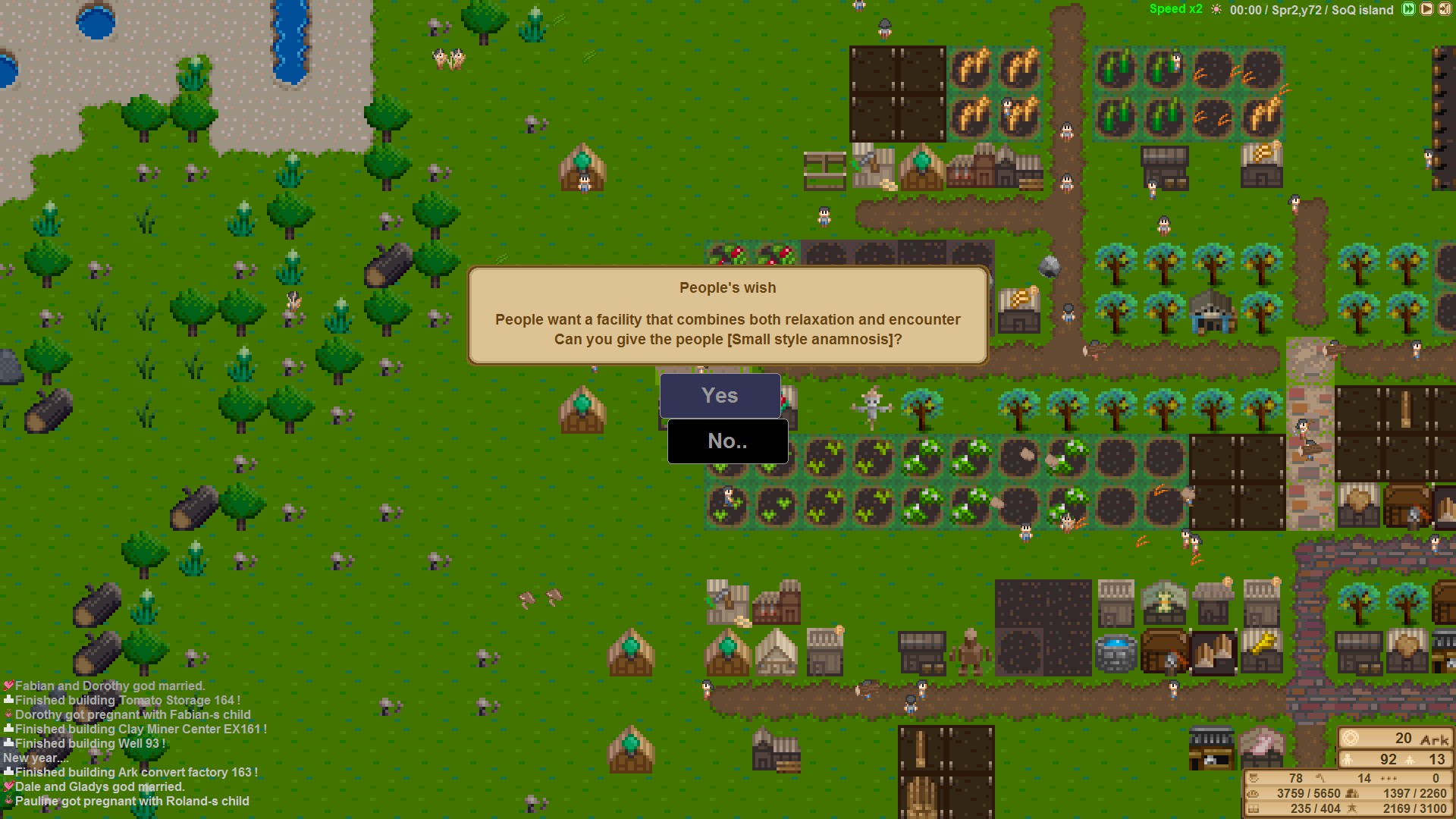
By your bootstraps
After being dumped on the island, you have a few houses, a mushroom and herb warehouse if on less than hard difficulty, and a clearing on which you need to immediately start building storage areas to be able to collect anything with which you can start building. Islanders are annoyingly blind to anything not in a storage yard or warehouse, and if they get new orders, they tend to drop things and forget about them, even when they’re hard to replace or outright finite resources. At first, you can manually designate islanders to collect specific items from specific locations, but you want to start setting up “centers” that can employ islanders as full-time collectors of specific resources, if only for your sanity since you do not want to have to manually right-click each islander to give manual orders to collect each mushroom on an island with 500 residents.
AFTER you have built a facility that collects or manufactures an item, you can build the warehouse that can store it, and you can’t use the item until after it’s in its own designated warehouse. Only apples can go in apple warehouses, you need to discover oranges, unlock orange trees, build an orange tree, grow an orange to unlock orange warehouses, then build an orange warehouse to then finally start storing and distributing oranges as food, as well as reveal whatever comes next on the tech tree.
Nearly all the game’s mechanics are invisible to a new player. An experienced player will know what order to unlock things in to progress quickly, but a new player is frustratingly blind as to what is even expected of them. Progressing through the game requires fulfilling culture requirements that first require prerequisites you aren’t informed how to fulfill.
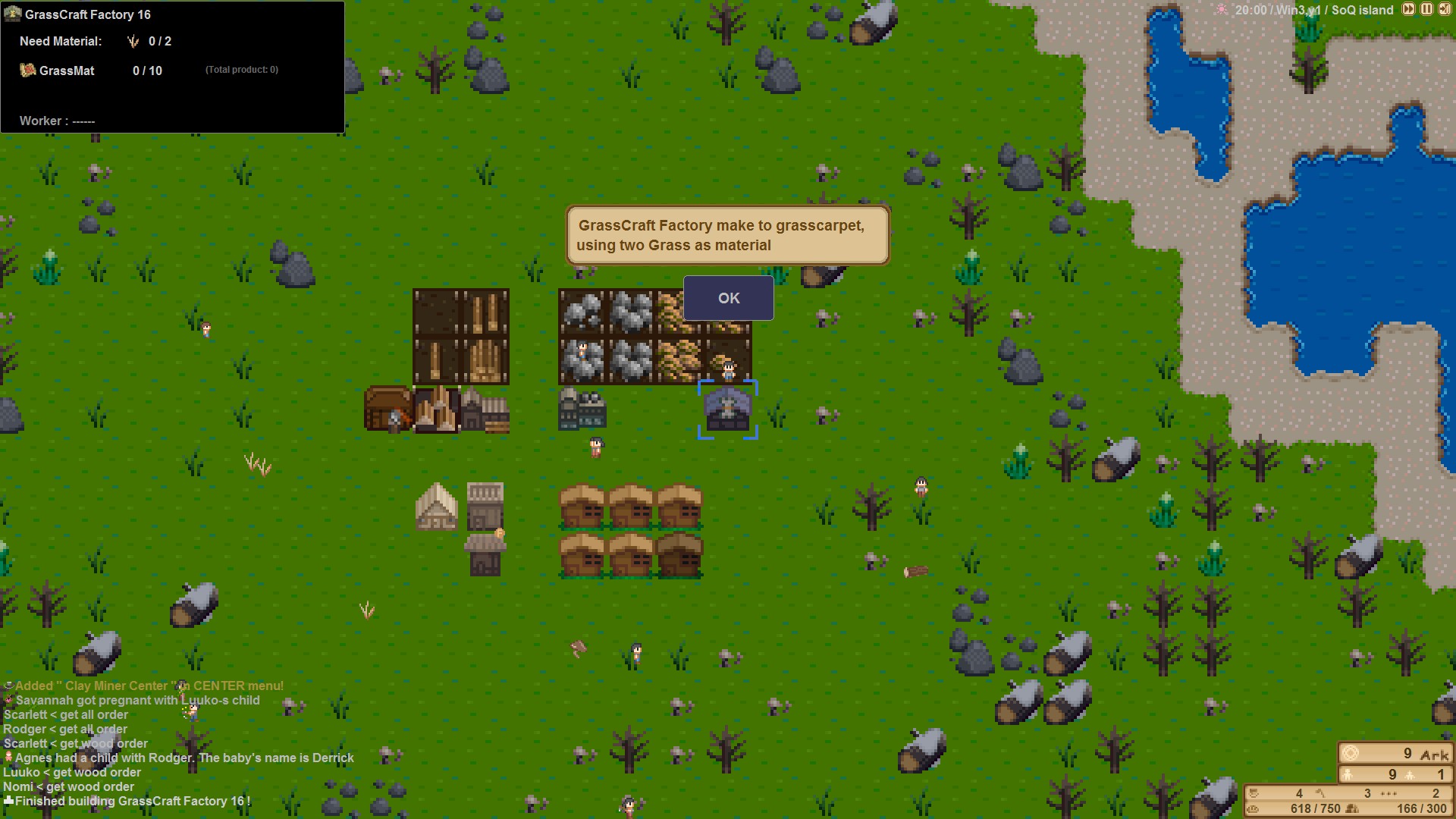
The start of the game is slow. It is very, very slow.
You need to wait for children to be born and then grow up before you can start staffing any serious kind of industry. Also, I quickly noticed that newborns were listed as 3 years old, and everyone had ages that were multiples of three. Apparently, even in a game where it expects you to be playing an island for one thousand game years, people’s lives are too long, so every game year increases the age of each character by 3 years, so characters hit adulthood at 5 actual game years, and start dying of old age in 20 game years. There’s an initial baby boom, but without once-per-game event buildings (the initial versions of which have severely limited range) upping fertility and age limit, there’s a population crisis, and it’s difficult just to keep your island’s core functions staffed. Deaths and births can often come in waves, so you can be treading water, just to have 12 people die of old age all at once with only a couple children reaching adulthood on the horizon, while other times, you can have a dozen unemployed extra adults. This can actually be part of the game’s charm, as it can keep you on your toes and make you prioritize, but it’s still a drag early on when you need to expand to get to the point where the game can actually engage you.
There game also uses “culture level” to segregate different stages of development, and many unlocks have culture levels as prerequisites. Culture levels are often arbitrary hoops to jump through, and stall your game until you clear their requirements, but their requirements can often be based upon things that take a long time to achieve, such as making 10 trades through a port when ships coming to port require long pauses between each even when you can fulfill their requests. Deny their request because it’s either a ludicrously bad trade or because you can’t bring what they want to them, and you have to wait several game years for another one.
Beyond that, however, the game has a special currency called “Ark”. The game constantly reveals new things you can build, but then holds it back behind spending Ark. You gain Ark for milestones like building certain numbers of roads or population milestones, but most Ark comes from getting 1 Ark per baby born, or using an Ark factory where you sacrifice 200 food to get 1 Ark. It certainly seems like everything costs way too much Ark (every kind of crop field – whose effects are often redundant – costs 10-50 ark, and some buildings cost 300 or more, while you get ark in a trickle of 2-3 per minute of playing), so you’re often just sitting around waiting for more of it early on. By the late game, you eventually start finally hitting the end of the unlock trees, and can splurge on things you want rather than things you’re guessing is the one the game forces you to take, but it’s a very, very long road to get there.
To make matters worse, to progress, you need certain things that are often hidden until you reveal them by building some unintuitive prerequisite building that is gated behind an Ark cost. If you have experience playing the game, you know the order of things you need to unlock, but to a new player, you’re blindly guessing and punished for mistakes by having to wait through half an hour more waiting for more ark to accumulate to guess again. I never bothered unlocking corn, because it seems the same as wheat, but with an additional ark cost to unlock, so why bother? But maybe there’s something that unlocks when I start building corn fields? I correctly guessed sheep were worth buying because the description listed their product as wool, not meat, so having a sheep pen unlocks wool storage, which unlocks seamstresses, which create wool coats that “reduce chance lose stomach”.
Even more infuriating than this, however, is that in this game where islanders die so constantly, buildings do not rehire new workers without you manually clicking the hire button unless you explicitly build a type of “office” specific to that building (there’s one specifically for farms, factories, transportation buildings, etc.). Each one of these buildings needs to be unlocked for hundreds of ark apiece, and are several times more expensive than many types of buildings critical to progress. Essentially, the interface forces you to constantly pause and check for understaffed buildings (completely unstaffed buildings are shaded blue, but understaffed buildings that can hire more than one have no visible clue they are understaffed, and you have to manually right-click every building on your island periodically to check every few minutes – this seriously took up about half my playtime), and the game holds the ability to do this automatically to ransom behind even more tedious grinding for absolutely no reason. In other words, this developer made the game’s interface terrible on purpose, and he deserves a slap in the face for this.
Other elements of the interface do not exist until you have a specific building constructed, which often is hidden behind unintuitive prerequisites. You can’t even check how much total food you have stockpiled until you build a government office, for example, and I can’t even tell you what unlocks that building. (Number of warehouses, maybe?) There is absolutely no way to check charts of how your supplies of different products have risen or fallen over time. (Those would be appropriate pieces of interface to hide behind some kind of unlock, not basic functions!)
To put it another way, I’m a Dwarf Fortress player. Dwarf Fortress’s interface is vastly, vastly better than this game’s interface. Nothing about this game’s interface is correctly designed. Everything takes too many clicks. You cannot see how much you have of anything without manually clicking on every single warehouse. There is no way to see the rate at which anything is being produced. The interface outright lies to you in many places. If I see two stacks of bricks in a brickyard, it can mean anything from 6 to 14 bricks are contained there, and I have to click to find out how much. If something is going wrong, I often have no idea why unless I manually trace through the entire supply chain. In fact, there’s many times that I don’t even know if things are going wrong. Sometimes, I notice I’m totally out of grass, I don’t know how long, and I can’t tell how much my wheat and rice production (plus everything further down the production chain than that) has been suffering.
The means of production
Another thing of note is that the production chain in this game is rather strange; You feed your sheep “potetos”, and a “poteto” field requires wild-picked herbs to grow. You grow wheat and rice using wild grass. To go fishing, you need wild-picked mushrooms as bait. (To say nothing of the fact that its technology is wildly anachronistic – you can create ice cream parlors before discovering ironworking, much less electricity or refrigeration.)
This sounds very strange, and is rather unintuitive, but it’s actually the most clever thing this game does. You see, most city-builder games tend to be very stable. Once you build it, it runs completely on its own so long as there isn’t any major supply hiccup, and that can get kind of boring. Games like the Sierra city builder series (such as Pharaoh and Cleopatra, also on Steam) are interesting while you set up your city, but you often have objectives to complete (like building a massive pyramid) that take long stretches of time just waiting for limestone to be mined, taken to the build site, and graaaaadually constructed. Once you’ve built and staffed a farm, an infinite fountain of food or other resources gushes forth, and supply chains take care of themselves.
Your Island, however, makes basically every product ultimately depend upon a resource that grows semi-wild. Trees are the basis of the economy – grass, mushrooms, and herbs only grow adjacent to trees, and only at certain times. (Mushrooms and grass need rain to grow, and they die off during the winter, and die off more readily on higher difficulties, creating built-in supply shocks.) You can plant more trees using a shop for it, but it takes grass to work, and you also consume grass feeding cows or growing wheat or rice. It also only gets more complicated from there; If you want to make wine (or “red beer” as the game calls it in the winery description), you need wheat (for some reason) and grapes, which take fertilizer to grow, which is made from fish, which take mushrooms to catch. If you run out of grass while chopping down all your trees for building material or firewood, you can actually devastate your ecosystem and economy. Inversely, setting up lots of tree growing stations without having enough lumberjacks to counter them can eventually choke out the whole area with trees, which can block movement (leaving you trapped inside), as well as preventing growth of the grass, herbs, and mushrooms you need due to no spaces being left for them. (It’s volatile based upon season, but it seems about 3 tree planters to 2 lumberjacks is about right.) To make matters worse, while trees are planted (or chopped, for that matter) only within a designated radius around the center that plants them, you have no control over exactly where they are planted, and the stupid AI is of course extremely happy to create walls of trees while the lumberjacks will of course chop down the most obstructive trees last.
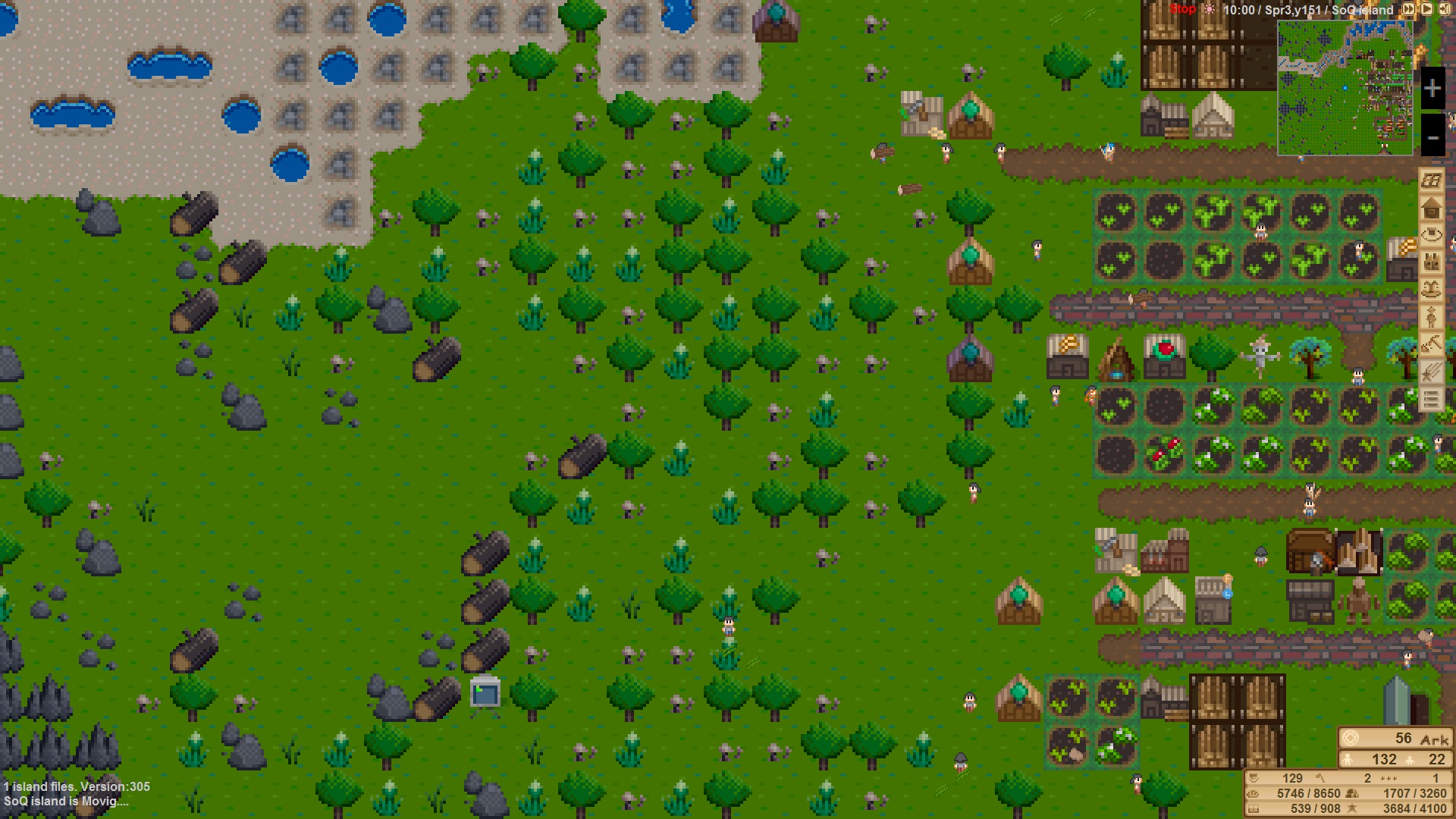
In essence, unlike the annoying babysitting of factories to rehire dead people this game does, this is actually something that makes players have to check the balance of nature and constantly readjust their resource usage to take advantage of what’s available at the moment. By making the stability of the economy depend upon uncertain resources you have little control over, the game makes you constantly have to readjust your plans and watch over a volatile set of resources. Further, it naturally discourages over-reliance upon any one resource, as you tend to gain grass, mushrooms, and herbs at the same general ratio. Not using herbs means leaving them near the trees to take up space that could grow mushrooms or grass, so you have to find some way to get rid of them, and therefore, you should probably use them to sew “poteto” fields, rather than relying entirely upon wheat.
Not all resources are organic, however. Most buildings and every tile of road takes stone to build. Stone generally does not regrow on its own, meaning you need to constantly expand outwards to devour all the stone you can get. Fortunately, destroying completed buildings lets you salvage the resources built in them… if the stone is near a storage yard that has space and the villagers feel like working that day and didn’t get lost or hungry on their way and decide to go back and check out that new sandwich place, instead. Basically, it’s a crapshoot if you’ll recover resources that can be rather finite on the map. Clay diggers let you gather stone as well as clay from sand (sand and clay are two different things, but whatever), but while it says in the game that rain can “rarely” make sand refill, I have literally never seen this happen (while other things described as “rare” happen all the time), so it turns out this is also a finite resource. Instead, you can upgrade your mason centers (which actually mine stone, not build with it) and clay diggers to obtain “rare” materials like crystal and gold. Gold is dug up from sand and for some bizarre reason used to make upgraded rice balls, but crystals are used in observatories to cause meteors to fall within an area around it that can be mined for more stone which can also have more crystals within it. This kinda-sorta makes for a stable supply of an otherwise finite resource, but calling down random orbital bombardments controlled only by the observatory’s effect radius upon yourself is spectacularly unsafe…
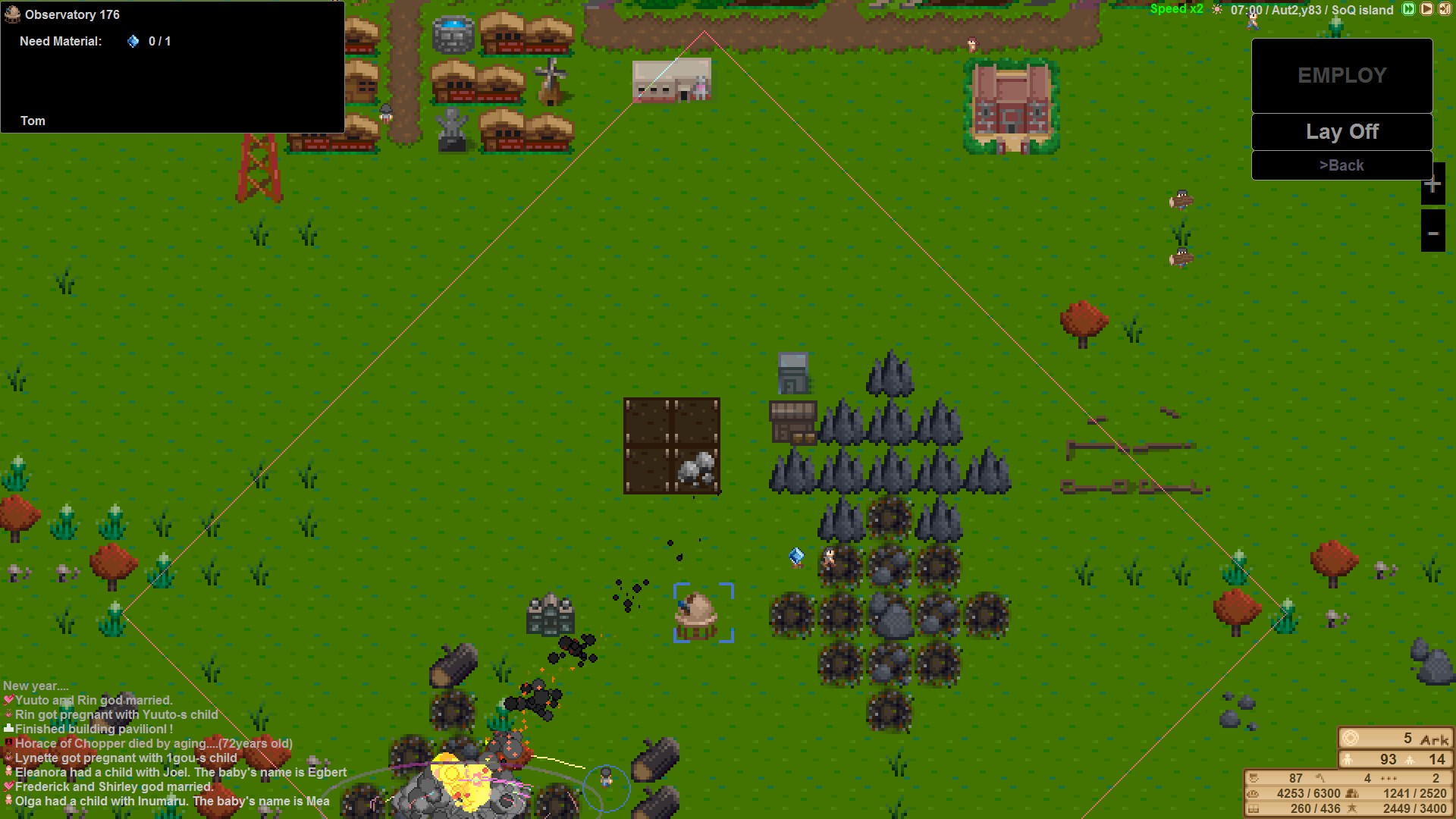
Surprise mechanics
However, there’s also a serious problem with the way that the economy of this game is set up, and that’s that there is really only one ultimate resource that matters, and it’s food. All food just generates “food value”, and while some is more efficient than others, it’s all just food in the end. You can give people grass mats and other non-food items, but all it does is reduce the need for food, so ultimately, it’s worth is measured in food. Everything is food, and combined with the wild supply shocks and utter lack of information through the interface means that no matter what is wrong, the only way the interface will show you something is wrong is to say you’re running low on food.
When I first hit culture level 2, the game introduced the “environmental” mechanic completely by surprise. It’s actually very similar to the much-better-named desirability mechanic of the Sierra city builder series, where many types of buildings have an effect upon the desirability of a neighborhood. In essence, parks and prestigious government buildings make a neighborhood desirable, creating an aura that pumps up property values and makes people happy to live nearby, while warehouses, mines, and factories are stinky and noisy and gross and nobody likes living near them. It makes you plan your city around having a pristine cloistered urban center with beautiful buildings and parks buffering the citizens from the ugly factories around the edges of town. The key term there, however, was “plan”. You could plan your city in a Sierra game like Pharaoh because the game told you what desirability was before it was sprung on you. Your Island prefers to let you build a city, go 30 game years, then tell you that there’s now a mechanic that punishes you for building your storage yard near the housing and so you have crap “environmental” because of it.
However, that’s not all. In Sierra games like Pharaoh, desirability was a key factor in housing quality. A basic hut could house 4 people, but as desirability rose and as you supplied more and more needs and desires of citizens, you could cram 40 or more people into the same tile. In a game where space was constantly at a premium, this heavily enforced making as much of your housing as desirable as possible to keep population density high.
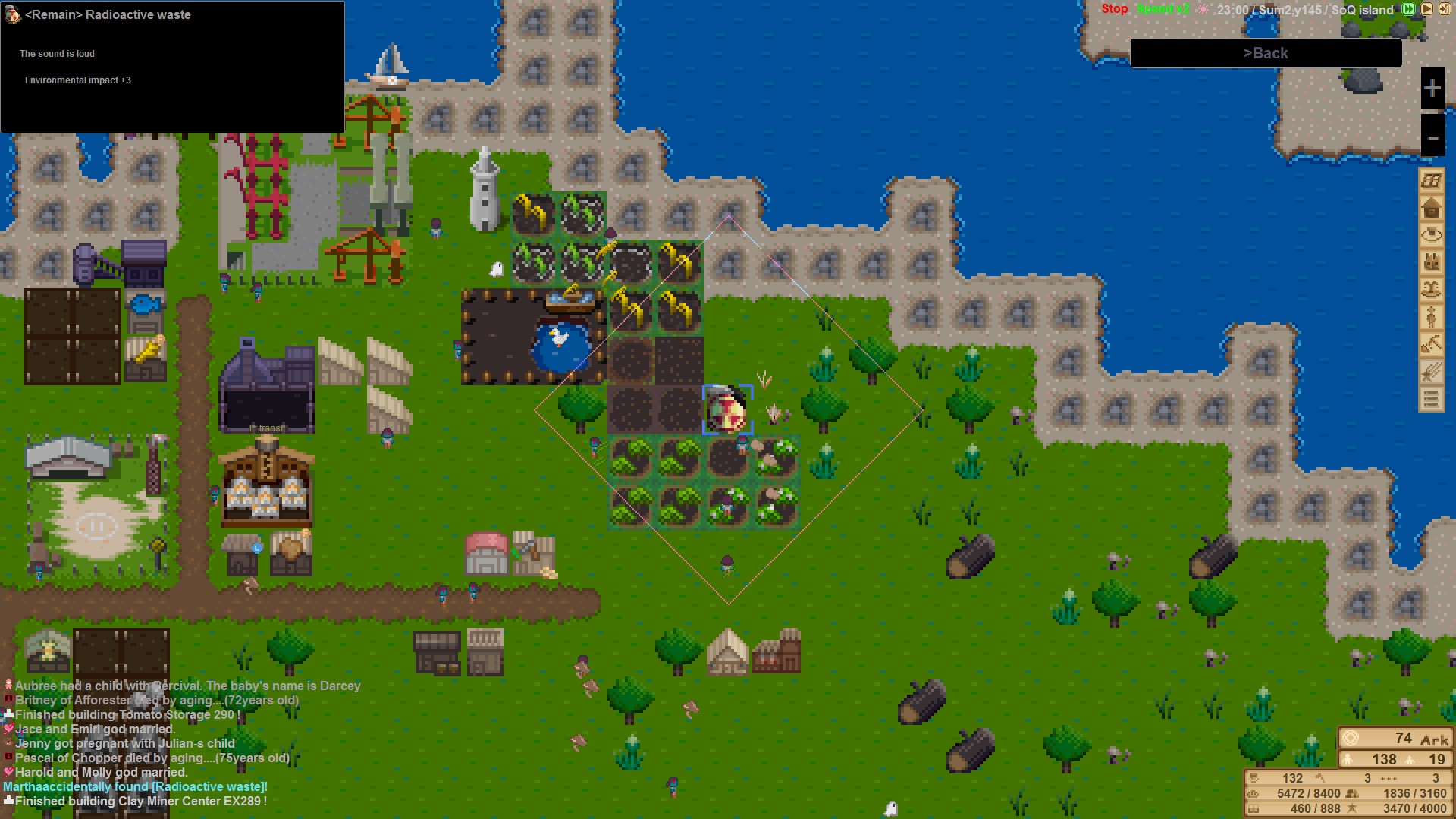
In Your Island, however, there is no mechanic but food, so all “environmental” does is reduce food consumption… or increase it if you’re low. This meant that because I was blindsided by “environmental” as a mechanic, I started out with only 3/10 stars of “environmental” for several of my houses. (Also, only a few objects in the game give you any clue what they do to “environmental”, and you have to guess at whether apple pie factories are good, neutral, or bad for “environmental”, because they’re the shops that people buy the pies in, so they have to be put near houses, but they are also still factories, so they might be undesirable like other factories?)
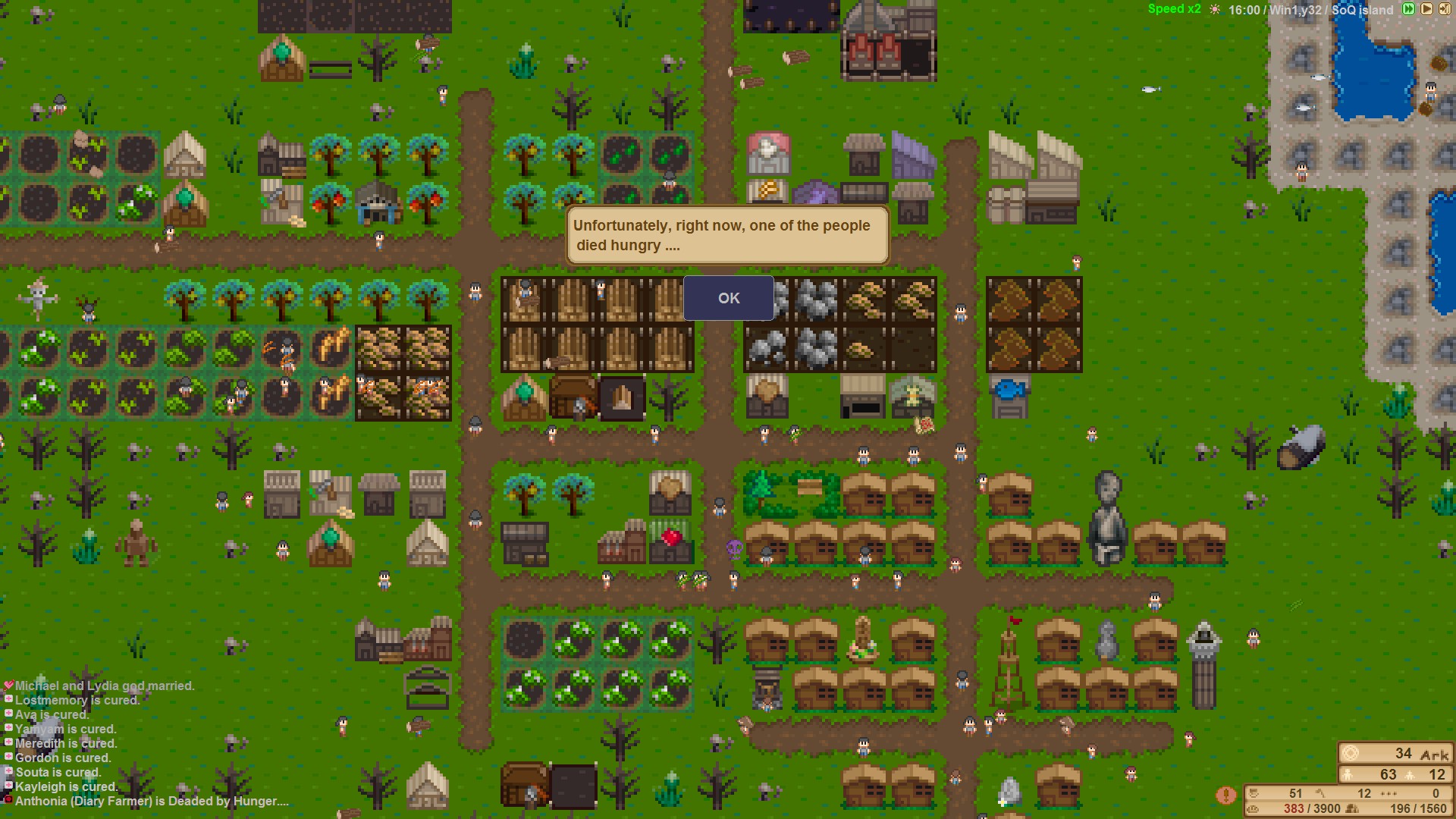
At first, I didn’t realize what was happening – I noticed that food was going down after a while, but didn’t understand why it was going down so fast. I did the obvious thing – build more farms – but that didn’t help. Even building twice as many food-producing factories as I had before hitting culture level 2 when I had basically the same population did nothing to stem the tide of dropping food levels. Eventually, people started starving.
What was the cause of the problem? I had run out of firewood. Yes, that’s right, people were starving because they ran out of firewood. I had up until that point only built one firewood chopper (even though I was drowning in extra wood), because one had been enough to supply the island until that point, but I eventually had enough people burning firewood in their homes, plus I had built extra bakeries that burn wood to make bread that I had run out, and apparently, the “reduce chance lose stomach” effect of firewood actually makes a difference of a factor of about four or five times the normal rate of food consumption. Building three extra choppers to meet demand suddenly meant I was flooded in food again. What’s key to this, however, is that there is absolutely nothing in the interface that told me a lack of firewood was a problem. The interface only told me I was low on food, which was a symptom of lack of firewood. I only noticed that the usually-full firewood yard was empty by happenstance, and then looked at each individual house to check that they were out of firewood, and that solved my problem, but it took twenty starved villagers before I figured that out.
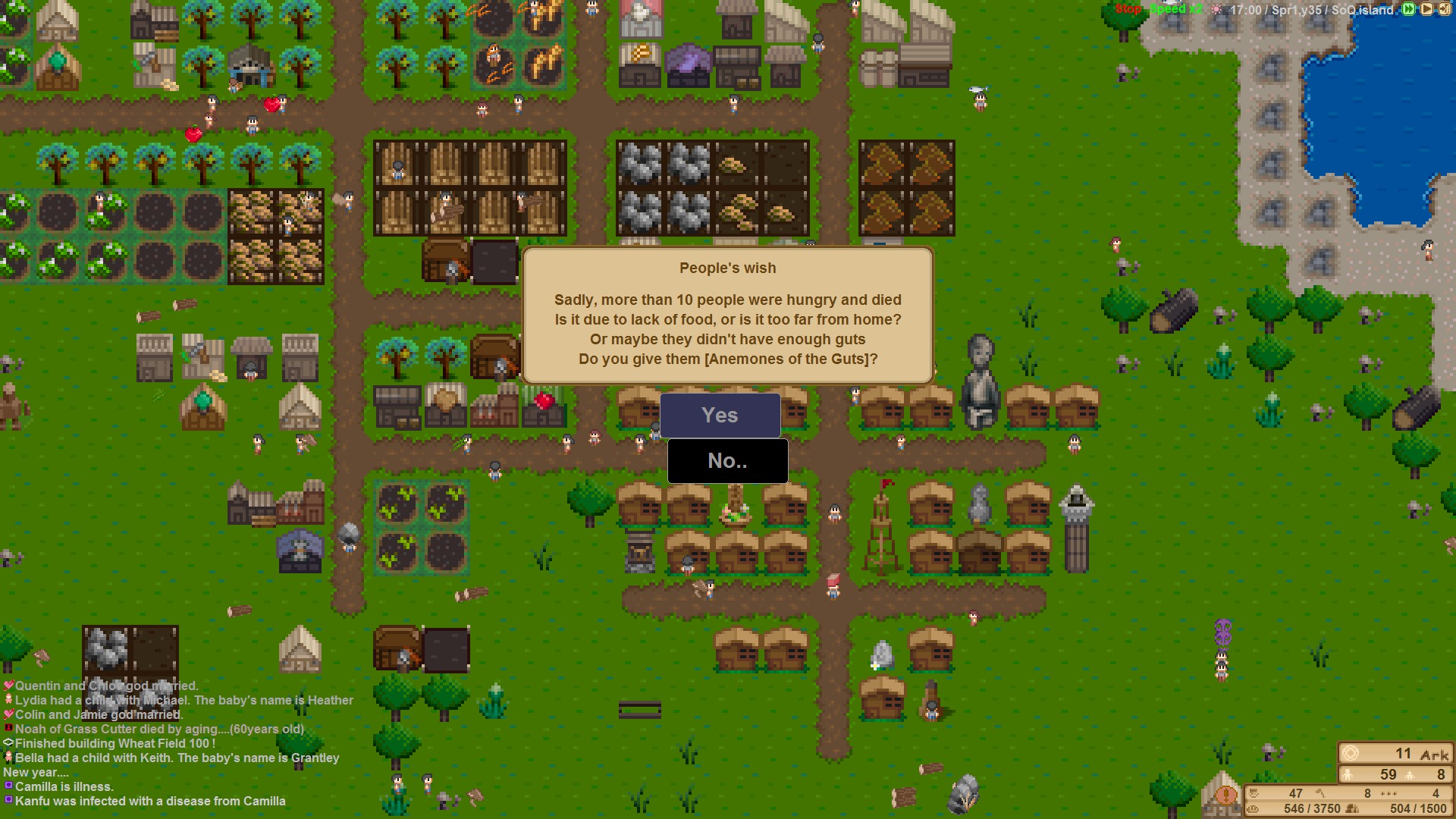
Having 10 people die from starvation, however, made the event above pop up and gave me the “Statue of Good Eat the Air”, which reduces chance lose stomach of people living in houses within a range of 3 tiles. So yay, I guess, I’m supposed to starve my people… for their own good, of course… well, not the dead ones, but on the whole, it’s for their own good.
I also needed to start destroying my original storage yards and houses to segregate them out more, and started building parks in their place, as well as using event buildings that have positive “environmental” to boost desirability up to around 6 or 7 stars, and that also seemed to halve the food consumption rate, making my food warehouses overflow. That was until I discovered a few random relics that made all my old housing obsolete and basically dictated how I would build houses from then on. Some random relics like King Tut’s golden mask can give “+3 environmental” for a few tiles radius, but Japanese relics like a crashed Zero fighter or Tokyo Tower give +12 over a large radius, basically dictating that all future housing be built next to them, as they instantly maxed out my desirability… until I found “Holy Mountain Yugdrasil”…
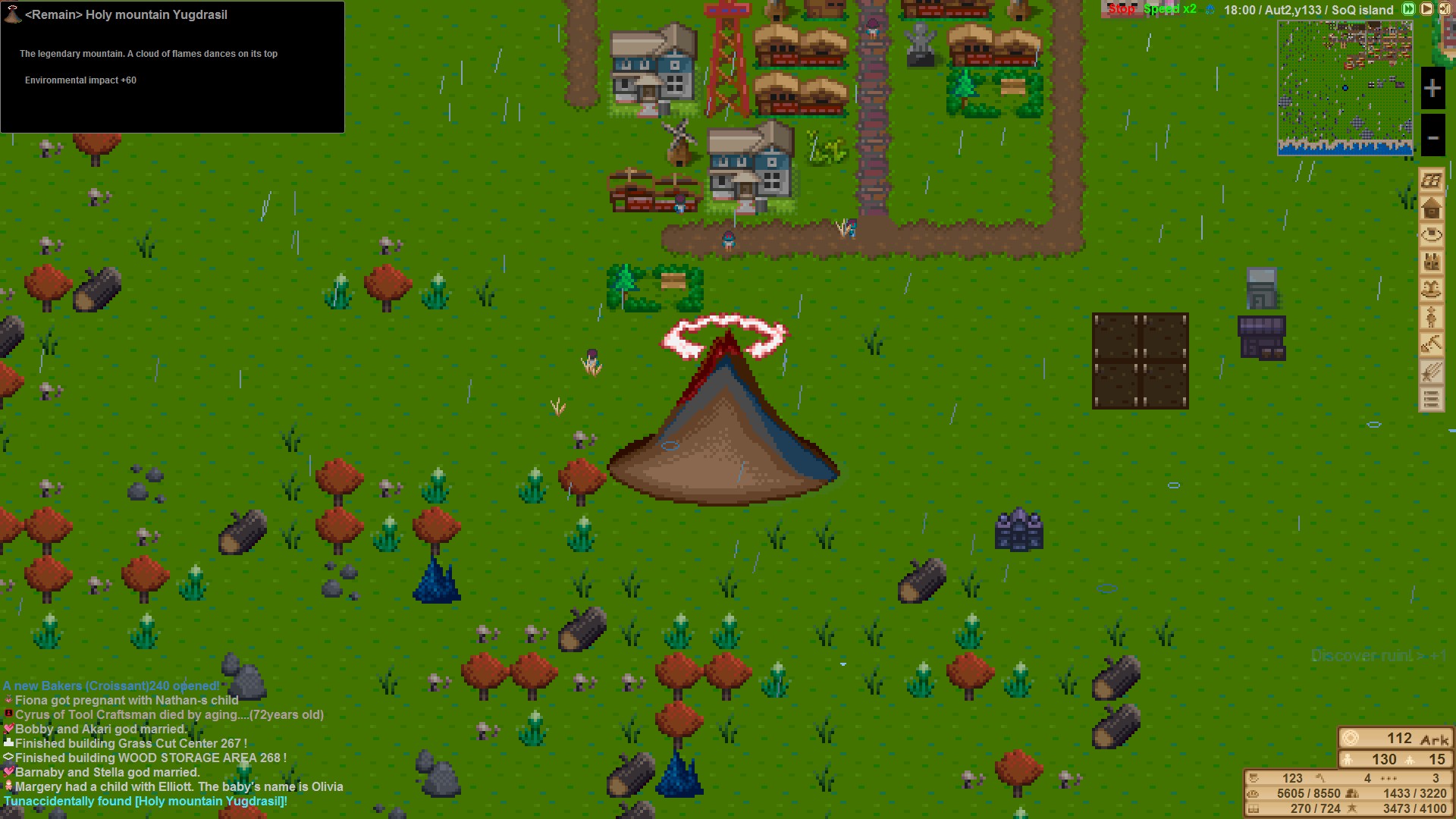
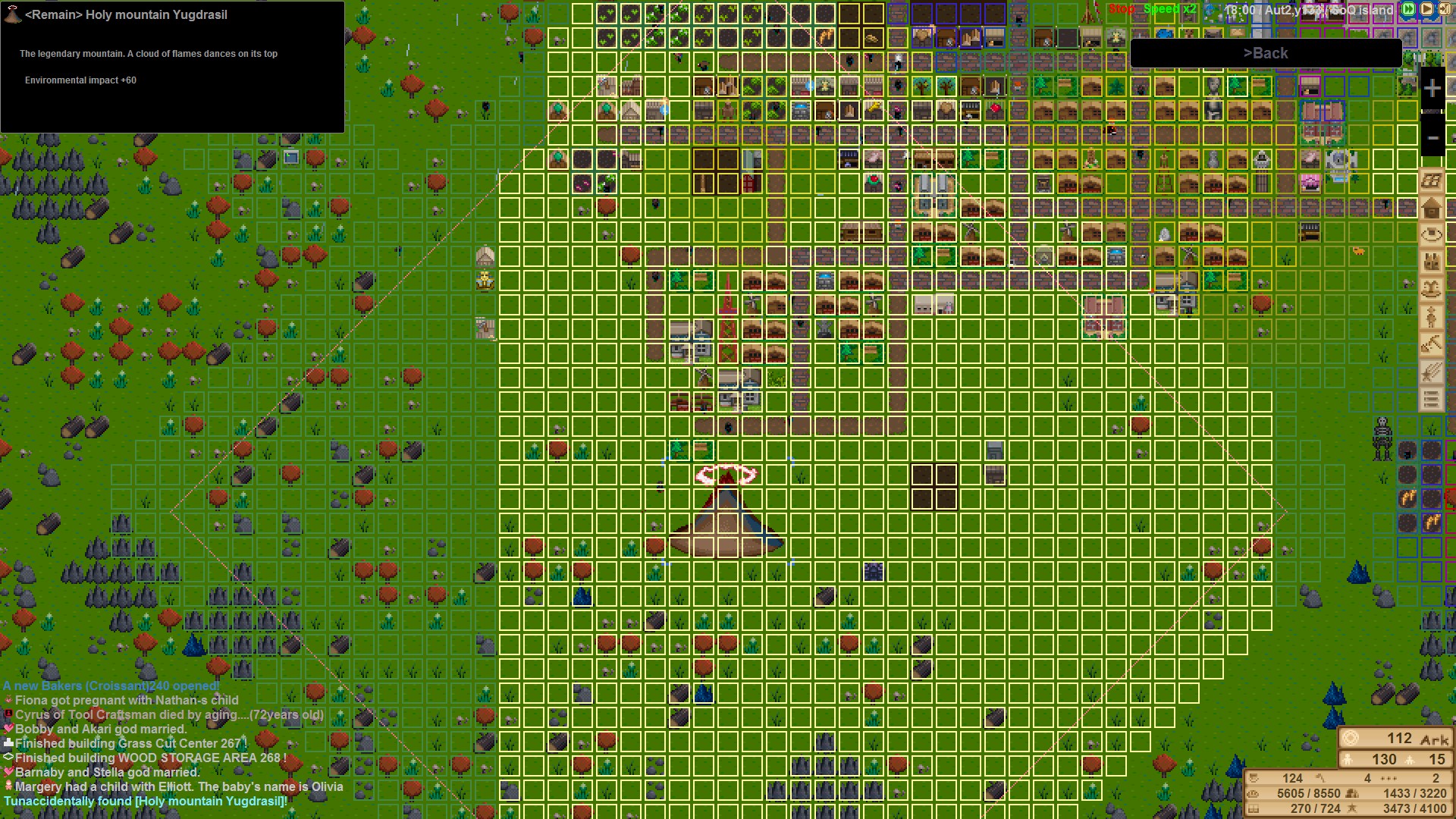
Did I mention this game has no balance? Once you find something like this, all your old plans are obsolete, there’s no reason not to make it the center of your city. It makes everything leading up to finding it feel like a waste of time. At least things like parks don’t just add desirability, but also extend lifespan of nearby residents, so they aren’t completely obsolete, but event buildings are unique, so you can’t move them.
There is a “manual” page in the interface, but it doesn’t show mechanics that haven’t been introduced yet, it only covers the most basic and obvious of things, not anything of value, and it’s just as Engrish as everything else. For example, one entry is labeled “about drowning”, and it explains that people die when they starve to death. (In fact, it doesn’t seem like villagers candrown in this game…)
If you go into the “books” section from the main menu, it actually lists the different food values of different types of foods. This is where you learn this game has no balance and hides the interface to avoid telling you. For example, early on, you get a bakery that lets you turn wheat (made from grass) and fuel wood (refined from regular wood at a chopping station) into bread. Wheat has a food value of 16 and bread has a food value of 26, so turning a wheat and a small amount of fuel wood into bread makes sense. Later, you get the option to spend Ark to have new recipes for your bakeries, like croissants. This takes one wheat, one milk (food value 17) and fuel wood to make croissants worth… 23 food value. In other words, you’re paying more for less. Or maybe they are worthwhile somehow because it makes more croissants? It doesn’t say this, but when I watched the bakery just to check, it seems it does create 2 croissants at a time – although it’s still not a better deal than bread. However, watching croissants being taken to a house shows that it actually gives 26 food value, so the “book” section is apparently lying, and I’ll need to manually observe every food item being collected and write down my own notes for every food item, so screw it! I don’t know! I could just trust that everything is balanced, but this is an indie game with no quality control whose interface gives outright false information, so that seems foolish.
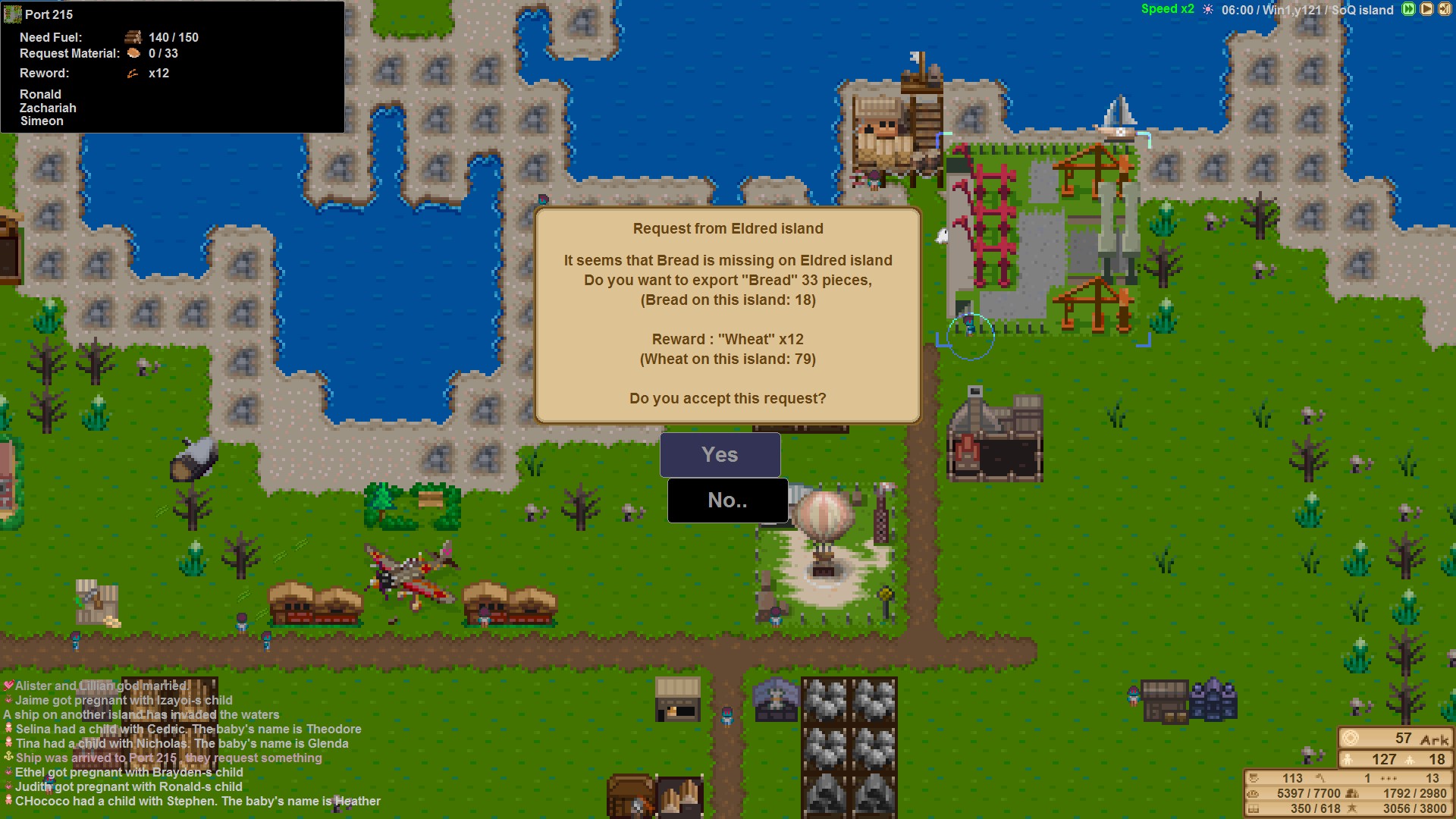
It’d sure be nice if the game explained any of the things I actually need to know to make informed decisions! To make matters worse, the only way to even look at the “books” section to learn any of this is to quit your game and exit to the main menu, otherwise, you’re stuck with the worthless in-game manual that tells you drowning means people die from starving.
Supply lines
Some of the more advanced tools at your disposal are advanced logistics buildings, such as railways and balloons.
To be honest, I didn’t really figure out how to use railways. As soon as you build a rail station next to some tracks, it creates a minecart (described as “torokko” in-game) that bounces from one end of the tracks to the other at hypersonic speeds, hypothetically carrying supplies with it. There are, however, many problems with tracks. First, stations need to be built within a few tiles of the warehouses or storage they take from, and have tracks connected to them. This is a 2d game, and there are no railway crossings, so you have to break through roads and tear down buildings to build tracks that go through different areas, or else build massively circuitous routes. The later you get started, the worse this gets, where you’ll need to completely destroy a quarter of your city if you want to set up railways. Second, tracks also cannot be built near the sand on the edges of water, and you cannot build tracks over bridges, so the rivers that crisscross most maps also deny rail travel. Third, there is little control over what gets shipped. Stations just take materials and deliver them to other stations. Hypothetically, this would be good if you have far-flung mining stations where you just want to grab distant resources and bring them back, but that brings us to the last problem: Fourth, tracks require 1 wood per tile of track, and require significant building time per tile – by the time you’re done building the railway, you’ll have long since extinguished any resource you built that track to connect you to.
In the end, they only make sense if you’re trying to connect something like a grass-producing area that you had to reposition further and further away as the “frontier” of your city expanded to your old rice fields that are still along the banks of a river. Something where you are constantly creating a resource that needs to move only in one direction.
A vastly superior alternative is the balloon. These hot air balloons consume lots of fuel wood, but wood is the one resource you wind up always having in spades, and in exchange, they let you take materials from any storage yard, warehouse, or factory, and send them to any other storage yard, warehouse, or factory of the same type anywhere on your island. Hypothetically, this is limited by fuel, but fuel is supplied to the landing pad, not the balloon, so it can be resupplied by the worker while the balloon is in flight, and if you put a wood chopper right next to the balloon landing pad (you should absolutely do this), it will never run out so long as the worker doesn’t go on break. Balloons are one of the few ways you can directly control where products are sent from the mid-game onwards, so they’re fun just to have a little direct management. As your city spreads out, workers will eventually not be able to connect resources gathered from the far reaches of the island to the central residential areas, so balloons are a great way to bridge massive distances, and shuttle finite resources like stone and clay from the far reaches of the island to where you need things built.
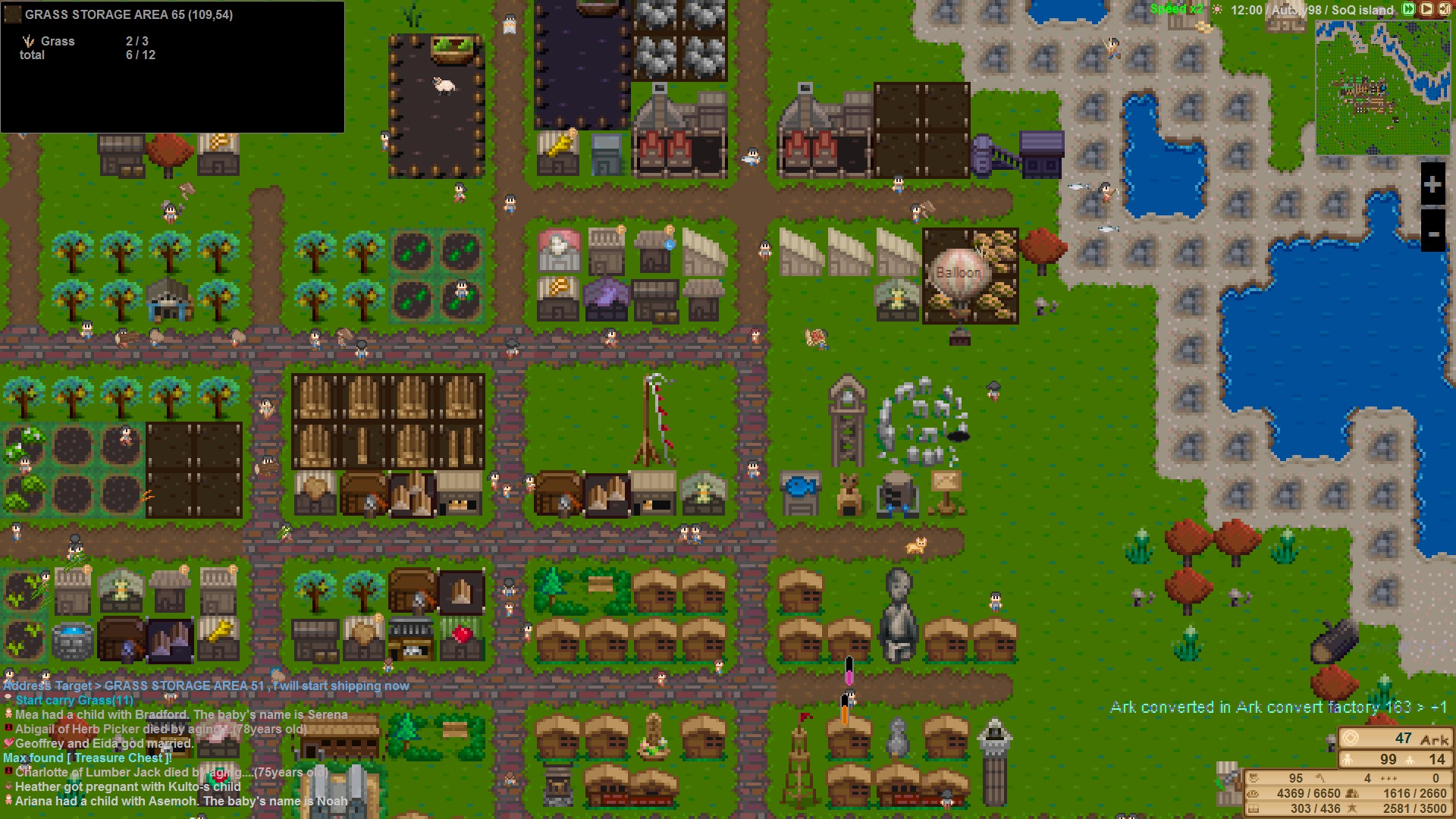
Sound
So far as music goes, there’s not much. Music seems to only start playing at strange points in time. In fact, I thought it didn’t have any music for a while, as it didn’t seem to start playing until after I’d gotten to a population of 100 people, which was about 30-40 game years, or about 6 real hours in. After that, it seems to play about 3-5 different songs at seemingly random times, but you can go extended periods without hearing any. The songs are decent synth-y songs that would be at home in a Super Nintendo game, but they are rather short and too few in number. If you like music as you play, turn the game music off, and just play your own music.
That said, don’t play your own music too loud, because sound effects are pretty crucial. A “donk”-like sound announces every death, and you need to be on the lookout for that sound to go check your log and chase down which factory just lost a worker so you can rehire. There are other sound effects, and you’ll get constantly flooded with birth messages and marriages that you don’t need to react to, so I wish I could turn them off. The “child has come of age so I can assign them to a job” event that should give a notification has no sound effect.
Verdict
This is a game I really want to love. At times, I really can just enjoy the act of trying to balance an unstable economy that relies upon unreliable seasonal base resources. At other times, I am either stuck waiting for Ark for unlocks, or being blindsided by poorly-explained or utterly unexplained mechanics from nowhere that demand I destroy half my island and try again. This is, however, mostly a series of frustrations with learning unexplained things for the first time, so experience smooths over the most glaring flaws.
This game isn’t listed as Early Access, but I get the sense that the Japanese just treat it differently than the so-called “Eternal Access” that’s used as a shield against any criticism. With some reworking, this game could be beautiful. It truly has a good deal of charm in its quirky cartoony sprites and the way that the personality of the creator comes out in the likes of giving you a “cat house” special building so that the children can have a pet cat that roams randomly around the island. Beneath the many, many frustrations is a genuinely good game that deserves to be excavated and put upon display.

